
计算机组装和维护

So you’ve selected your parts, double- and triple-checked their compatibility, and waited for economy shipping to bring them all to your door. It’s time to get to the fun part: putting them all together.
因此,您已经选择了零件,对它们的兼容性进行了三重检查,然后等待经济运输将它们全部带到您家。 是时候开始有趣的部分了:将它们放在一起。
Before you start, you’ll want to set up a good work area. Get some kind of table with plenty of room and light, preferably somewhere that isn’t carpeted. And you’ll need some time: a couple of hours, maybe more if this is your first time or if you have a lot of extras.
在开始之前,您需要设置一个良好的工作区。 获得一种有足够空间和光线的桌子,最好是没有地毯的地方。 而且您将需要一些时间:几个小时,如果这是您第一次或如果您有很多其他功能,则可能需要更多时间。
您需要的工具 (The Tools You’ll Need)
All you should really need for the assembly process is a Philips-head screwdriver. A nice set of bits is handy for larger or smaller screws, but everything else you need should be provided with your case and various parts.
组装过程中您真正需要的只是一把十字头螺丝刀。 对于较大或较小的螺钉,一组不错的钻头很方便,但是您需要的所有其他物品也应随您的箱子和各个零件一起提供。
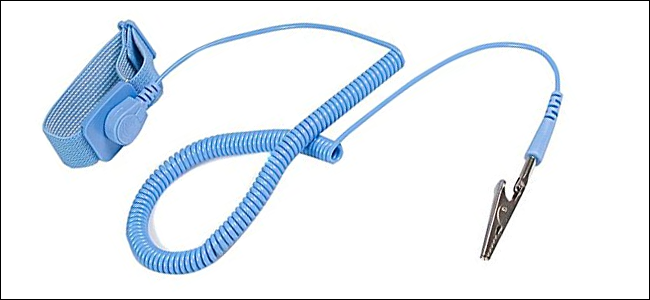
If your home or your workspace is particularly prone to static discharges, you might want an anti-static bracelet. This doohicky clips to a piece of metal (like the PC case) to electrically ground your hands while you’re working, protecting your parts from a discharge. To be honest, it’s very rare that a static shock will actually damage a PC part, and you’ll probably be okay just using the anit-static bags that come with your motherboard and graphics card. But if you want to be extra cautious, it couldn’t hurt.
如果您的家中或工作区特别容易产生静电放电,则可能需要防静电手链。 这种粘稠的夹子夹在一块金属上(例如PC机壳),可在工作时使您的手接地,从而保护零件免于放电。 老实说,静电冲击实际上会损坏PC部件的情况很少见,仅使用主板和图形卡随附的防静电袋就可以了。 但是,如果您要格外小心,那就不会受伤。
Finally, you might want to add a couple of cups or bowls from your kitchen, just for a place to put loose screws. (Or, if you have one, a magnetic parts tray is wonderful.)
最后,您可能想在厨房中添加几个杯子或碗,只是为了放置松动的螺丝。 (或者,如果您有一个,那么磁性零件托盘会很棒。)
第一:检查你的情况 (First: Examine Your Case)
First, take a look at your case. You’ll be able to spot the main compartment that holds the motherboard, the drive bays for hard drives and SSDs, the openings in the back for the motherboard’s ports and the expansion bays for graphics cards, etc. You should have a pretty good idea where everything’s going to go already—if you’re not sure, check the manual that came with it (or download it off the support web page on your phone. Remove both side panels while you’re at it, because you’ll need access to the inside from both sides as you build.
首先,看看您的情况。 您将能够发现容纳主板的主隔间,硬盘驱动器和SSD的驱动器托架,主板端口的背面开口以及图形卡的扩展托架等。您应该有一个不错的主意一切准备就绪的地方-如果不确定,请查看附带的手册(或从手机的支持网页上下载该手册。在使用时请卸下两侧面板,因为您需要构建时从两侧进入内部。
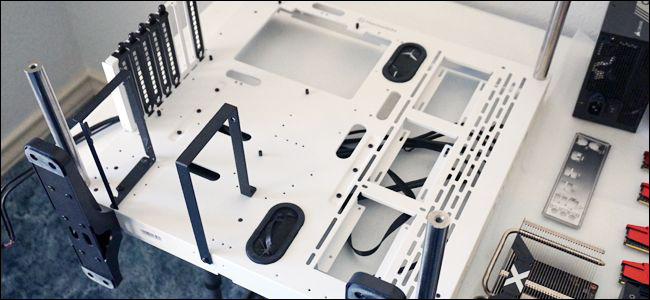
You might notice that the PC case we’re using in these photos looks a little strange. It’s a Thermaltake P3 enclosure, an open-air design with an acrylic cover, designed to show off all the components and not require any case fans. We chose it specifically so you could see the components clearly in these photos, but it doesn’t have exactly the same configuration as most box-style enclosure. Just imagine it with walls on an extra five sides.
您可能会注意到,我们在这些照片中使用的PC机壳看起来有些奇怪。 它是Thermaltake P3外壳,采用丙烯酸涂层的露天设计,旨在展示所有组件,并且不需要任何机箱风扇。 我们专门选择了它,以便您可以在这些照片中清晰地看到各个组件,但是它的配置与大多数盒式机箱并不完全相同。 试想一下,它的墙在另外五个侧面上。
第一步:安装CPU (Step One: Install the CPU)
We’re going to install the CPU and the RAM onto the motherboard before installing the motherboard itself, because it’s easier than installing them once the board is fixed in place. Take your motherboard out, put it on top of the box it came in, and you’ll have a nice little static-free test bench to perform these steps.
我们将在主板本身安装之前将CPU和RAM安装到主板上,因为比将主板固定到位更容易安装它们。 将您的主板取出来,放在其放入的盒子的顶部,您将拥有一个漂亮的小型无静电测试台来执行这些步骤。
Installing the CPU used to be a bit of a nerve-wracking process, but it’s become much easier as the designs have streamlined. Just try not to touch the electrical contacts on the bottom of the chip, and you’ll do fine.
安装CPU曾经是一个令人不安的过程,但是随着设计的简化,它变得更加容易。 只要尽量不要触摸芯片底部的电触点,您就可以做的很好。

The CPU will be in a plastic case or some other protector when you take it out of its box. Keep it in there for the moment, and take a look at the CPU socket on your motherboard—it’s that open area in the upper-left corner on almost all motherboard designs. There should be a plate that swivels up and down on a hinge (on Intel boards), and a lever that can be pressed down and clipped into the motherboard for safety (on Intel and AMD boards). Take a second to see how this mechanism works on your specific model—they vary a bit between processors and manufacturers.
从包装盒中取出CPU时,CPU会放在塑料盒或其他保护器中。 暂时将其放在那里,看看主板上的CPU插槽-几乎所有主板设计的左上角都是开放区域。 应该有一块板,该板可以在铰链上上下旋转(在Intel板上),以及可以被向下压并夹入主板以确保安全的杠杆(在Intel和AMD板上)。 花点时间看一下这种机制如何在您的特定型号上工作-处理器和制造商之间它们有所不同。
Raise the plate up, then take the CPU out of its protector. Look closely at the top and bottom (without touching the electrical contacts) and see how they line up in the socket. Most CPUs also have a small arrow in the corner—in the photo below, it’s on the bottom left of the chip. This will correspond to a similar arrow in the socket, so just line them up.
抬起盖板,然后将CPU从保护器中取出。 仔细观察顶部和底部(不要触摸电气触点),看看它们如何在插座中对齐。 大多数CPU的角上都有一个小箭头-在下面的照片中,它位于芯片的左下方。 这将与插槽中的类似箭头相对应,因此只需将它们对齐。
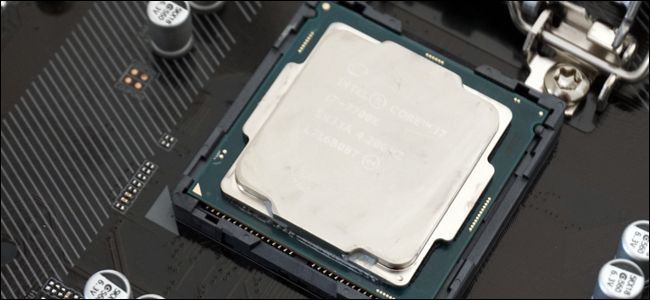
When you’re sure you know which way the CPU fits into its socket, gently slip it in. You should be able to let it go and it will simply fall the last millimeter or two. It should be flush with the walls of the socket. Now drop the plate, if there is one—if you can’t push it down all the way, stop, your CPU isn’t inserted correctly. Go back to the start of this section and start over.
当您确定知道CPU装入插槽的方式时,请轻轻地将其滑入。您应该能够放开它,它只会掉落最后一毫米或两毫米。 它应与插座壁齐平。 现在放下该板(如果有的话)-如果无法将其完全向下推,请停止,您的CPU没有正确插入。 返回本节的开头并重新开始。
If you can lower the plate all the way, great. Press the lever down beneath the safety tab. You’re ready to go on.
如果您可以完全降低板子,那就太好了。 向下按压安全标签下方的控制杆。 您已经准备好继续。
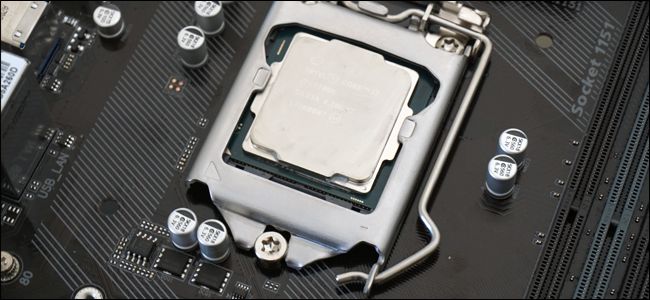
第二步:安装RAM (Step Two: Install the RAM)
Next, it’s time to install the memory modules. You’ll want to do this before installing the CPU cooler, since some aftermarket ones will hang over the edge of the RAM, making it difficult or impossible to put them in after the fact.
接下来,该安装内存模块了。 在安装CPU散热器之前,您需要执行此操作,因为某些配件市场的配件会挂在RAM的边缘上,从而使事后很难或无法放入它们。
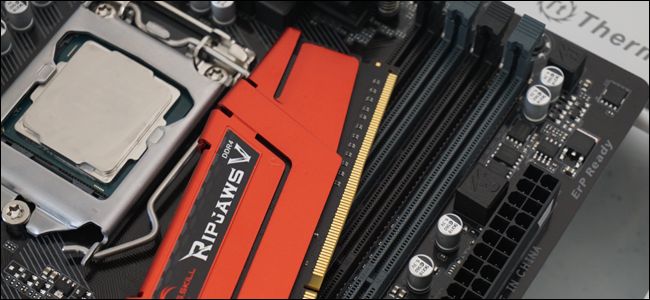
The RAM slots are the long, shallow slots with clips on both sides, usually to the right of the processor from your current perspective. Smaller boards might have only two, larger and more expensive boards can have as many as eight. We’re going to be inserting four RAM sticks (DIMMs) in our build.
RAM插槽是长而浅的插槽,两侧都有夹子,从您当前的角度来看,它们通常位于处理器的右侧。 较小的板可能只有两个,较大的板和更昂贵的板可能只有八个。 我们将在我们的版本中插入四个RAM棒(DIMM)。
Take a look at your own DIMM and its corresponding slot. Once again, you should notice that there’s only one way it will fit—look at the notch in the middle of the gold contacts, and line it up with the plastic bump in the slot. This should work no matter what generation of RAM you’re using: DDR3, DDR4, or something even newer. If for some reason your RAM won’t fit, it’s probably incompatible with your motherboard.
查看您自己的DIMM及其对应的插槽。 再一次,您应该注意到,只有一种适合的方式-查看金触点中间的凹口,然后将其与插槽中的塑料凸块对齐。 无论您使用的是哪一代RAM,它都应该起作用:DDR3,DDR4或更高版本。 如果由于某种原因您的RAM无法容纳,则可能与主板不兼容。
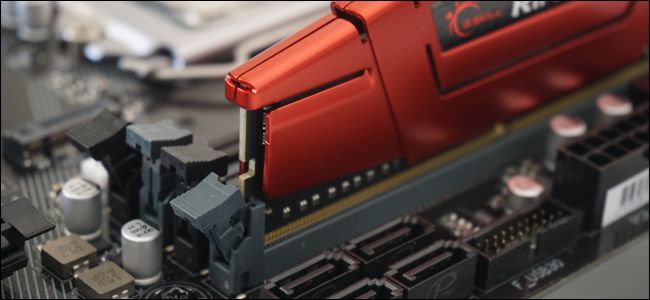
If you’re ready to install the RAM, fold the clips on the top and bottom of the slot down. Put the RAM in, contact-first, and press down firmly. The clips should snap back into place to secure the DIMM. Press down on the RAM at the top and bottom to be sure.
如果准备安装RAM,请向下折叠插槽顶部和底部的固定夹。 插入RAM,首先接触,然后用力向下按。 固定夹应重新卡入到位以固定DIMM。 按下顶部和底部的RAM进行确认。

Repeat the process for all the RAM modules you have. If all of them aren’t parallel, push down until they are.
对您拥有的所有RAM模块重复该过程。 如果它们都不平行,则向下推直到它们平行。
If you have fewer RAM modules than you do RAM slots, pay attention to which ones you fill up. Notice how the slots in the photos above alternate colors, black and grey? That’s because of the way they’re designed to work with memory channels going to the processor. In short, use ONLY the black or ONLY the grey slots if you’re not filling them up—substituting the colors for whatever your motherboard actually uses, of course.
如果您的RAM模块少于RAM插槽,请注意填充的模块。 请注意,上方照片中的插槽如何交替显示黑色和灰色? 这是因为它们被设计为与通向处理器的内存通道一起使用的方式。 简而言之,如果您不填满黑色或灰色插槽,则只能使用它们-当然,可以用颜色代替主板实际使用的颜色。
第三步:安装主板 (Step Three: Install the Motherboard)
Set your case down on the table, with the front panel on your right side. Remove the case’s access door and look down. That large slab of steel or aluminum is where you’re going to install your motherboard, and by association, a large portion of the pieces you’ve bought.
将您的箱子放在桌子上,前面板在右侧。 卸下机箱的检修门并向下看。 一块大的钢或铝板是您要安装主板的地方,根据关联,您可以购买很大一部分零件。
The first thing you’ll want to do is install the motherboard risers, small brackets that separate the motherboard from the case itself. Our ATX-standard motherboard uses six. They should be included in the box your motherboard came with or the box your case came with—if it’s not clear from looking at it, take a quick look at the manual. You should be able to screw the risers into their mounting holes with just your fingers; they’ll tighten in further when you screw the motherboard in place.
您要做的第一件事是安装主板提升板,这些小支架将主板与机箱本身分开。 我们的ATX标准主板使用了六个。 它们应该包含在主板随附的包装盒或机箱随附的包装盒中—如果不清楚,请快速阅读手册。 您应该只用手指就能将立管拧入它们的安装Kong中。 将主板固定到位后,它们会进一步拧紧。
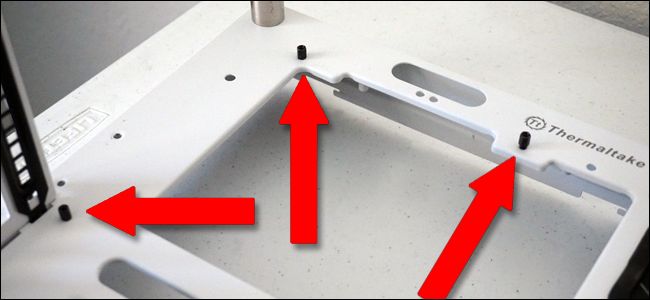
NOTE: Some cases don’t have a big cutout near the top of where the motherboard goes, like the one in the picture above. If you’re installing an aftermarket cooler, and your case doesn’t have this cutout, you’ll want to install the cooler before putting the motherboard in—so skip down to that section now, and then come back here. Stock coolers do not require this.
注:某些情况下,如主板上图所示,在主板所处的顶部附近没有较大的缺口。 如果您要安装售后散热器,而您的机箱没有此切口,则需要在安装主板之前先安装散热器,因此请立即跳至该部分,然后返回此处。 库存冷却器不需要此。
Before you place the motherboard itself in the case, install the I/O plate. This is a little piece of aluminum that fits in the back of the case, with cutouts for all of the ports on the back of the motherboard (to the left, from where you’re looking now). You should be able to slip it in and click it into place without any tools, though it may take a little force. Our open-air case doesn’t have a place for the rear I/O plate, so here’s what it looks like most of the time:
在将主板本身放入机箱中之前,请安装I / O板。 这是一块铝制的小片,可装入机箱的背面,在主板背面的所有端口上都有开口(在左侧,从现在开始查看)。 您可能可以不用任何工具就能将其滑入并单击到位,尽管这可能需要一点力。 我们的露天箱没有放置后I / O板的位置,因此大多数情况下如下所示:
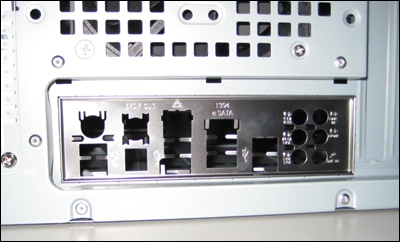
Now, take the screws that came with your motherboard and tighten them down into the risers with your screwdriver. Make them good and tight, but not so tight that they crack the circuit board. Make sure to use every screw for every riser: these are the only things that will hold up the motherboard, and all the parts connected to it.
现在,取下主板随附的螺钉,然后用螺丝刀将其向下拧入提升板。 使它们牢固,牢固,但又不要过紧,以免使电路板破裂。 确保为每个提升板使用每颗螺钉:这是唯一可以支撑主板及其所有部件的部件。

When you’re finished, your motherboard will be sitting on the risers about a quarter-inch above the frame of the case.
完成后,您的主板将位于机箱上方约四分之一英寸处的提升板上。
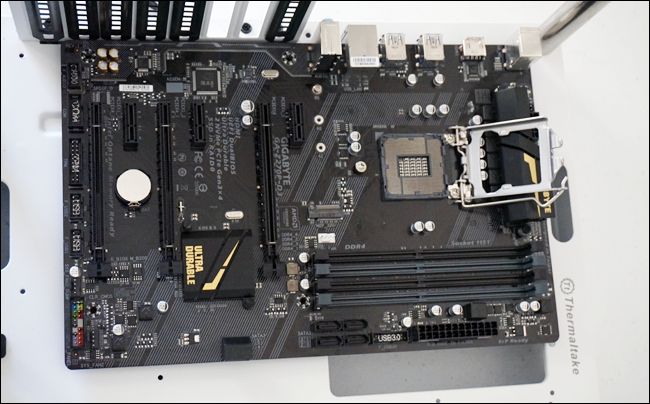
Make sure the I/O plate fits flush with the case and the various ports on the motherboard, bending back the metal prongs if necessary.
确保I / O板与机箱以及主板上的各个端口齐平,并在必要时向后弯曲金属插脚。
第四步:安装机箱风扇(如果适用) (Step Four: Install the Case Fans (If Applicable))
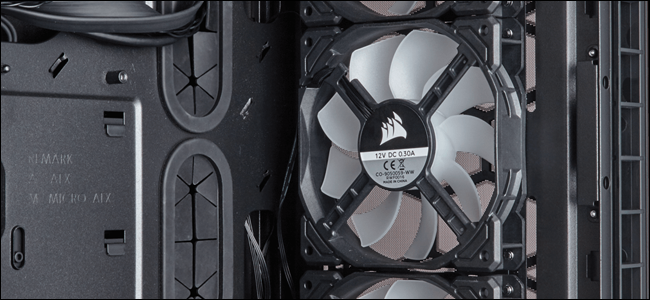
Next, install the case fans in the front, rear, and/or sides of the computer. (If they’re already pre-installed in your case, you can skip this step.) Install them now so you don’t have to worry about the components getting in the way later. Most of the time you’ll just screw the fans directly into the case, but some gaming-branded cases may have caddies or sleds for your fans, for easy removal and cleaning. Your case manual may have more information.
接下来,将机箱风扇安装在计算机的正面,背面和/或侧面。 (如果在您的情况下已经预先安装了它们,则可以跳过此步骤。)现在安装它们,这样就不必担心以后组件会受到干扰。 大多数情况下,您只是将风扇直接拧入机箱中,但是某些游戏品牌的机箱可能为您的风扇配备了球童或雪橇,以便于拆卸和清洁。 您的案例手册可能包含更多信息。
Keep in mind that where you place your fans—and which direction they face—matters. If you’re not sure how you should configure the fans for the best airflow, check out this guide.
请记住,将风扇放置在什么位置以及风扇所面向的方向。 如果不确定如何配置风扇以获得最佳气流,请查看本指南。
第五步:安装CPU散热器 (Step Five: Install the CPU Cooler)
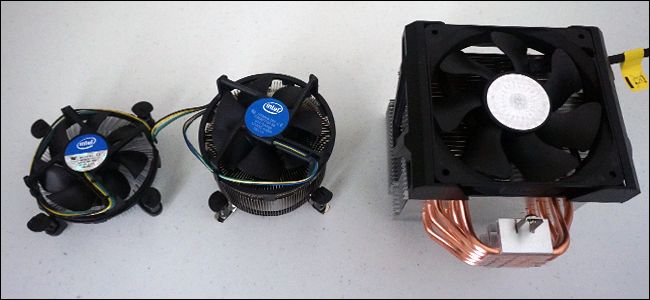
If you’re going to use the cooler that came with your processor (most of them include one in the box), this will be easy. The coolers that come with CPUs include thermal paste pre-applied to the contact, as do some aftermarket ones, making the process even simpler. Aftermarket coolers can range from easy to oh-god-why difficult, but we’ll walk you through what we can in that realm too.
如果您要使用处理器随附的散热器(大多数都在包装箱中),这将很容易。 CPU随附的冷却器包括预涂在触点上的导热膏,以及一些售后市场的导热膏,使该过程更加简单。 售后冷却器的范围从简单到令人难以置信,为什么如此,但我们也会带您逐步了解该领域中的能力。
库存英特尔散热器 (The Stock Intel Cooler)
There are four mounting holes a few millimeters on all four corners of the CPU socket. Just push down on the cooler and screw them in place—on the stock Intel cooler, the screws are plastic and mounted on springs, you shouldn’t even need any tools.
在CPU插槽的所有四个角上有几个毫米的四个安装Kong。 只需向下推冷却器并将它们拧紧到位即可—在库存的英特尔冷却器上,螺钉是塑料的并安装在弹簧上,您甚至不需要任何工具。

One the cooler is in place and secure, you’ll need to plug its power cable in. There’s a small three- or four-pin power port on the motherboard, very close to the CPU socket. Plug it in with the short cable to power the cooler’s fan.
一个散热器到位并固定好,您需要插入其电源线。主板上有一个小的三针或四针电源端口,非常靠近CPU插槽。 用短电缆将其插入以为冷却器的风扇供电。
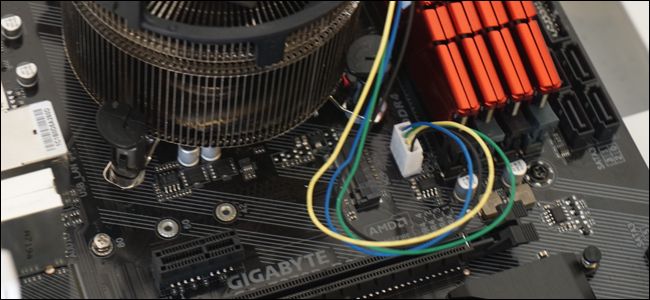
库存的AMD散热器(和一些售后配件) (The Stock AMD Cooler (and Some Aftermarket Ones))
AMD motherboards come with two plastic pieces on either side of the CPU, and the AMD stock cooler will hook onto these (as will some aftermarket ones). Line up the square metal hooks on the heatsink with the plastic notches on the motherboard, then press the lever down to lock it in place.
AMD主板在CPU的每一侧都带有两个塑料块,AMD的散热器将挂在这些塑料块上(某些售后市场也是如此)。 将散热器上的方形金属挂钩与主板上的塑料槽口对齐,然后向下按杠杆以将其锁定到位。
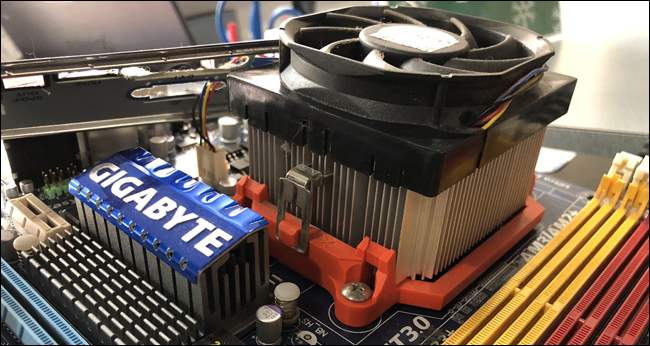
Some heatsinks may require you to screw down the hooks instead of pressing down a lever, but all of them will lock on with some sort of variation on this method.
有些散热器可能需要您拧紧挂钩,而不是按下杠杆,但是所有散热器都将对此方法进行某种形式的锁定。
大型售后散热器(适用于Intel和AMD) (Large Aftermarket Coolers (for Both Intel and AMD))
If you’re installing an aftermarket cooler on an Intel chip (or some AMD chips, depending on the cooler), the process is considerably more complicated. This final type of cooler contains a backplate and requires you to screw the cooler on using four mounting holes on the motherboard. (If you’re using an AMD board, you’ll have to remove the plastic pieces in order to gain access to these holes.)
如果您要在Intel芯片(或某些AMD芯片,取决于冷却器)上安装售后散热器,则过程将变得更加复杂。 最后一种类型的散热器包含一个背板,需要您使用主板上的四个安装Kong将散热器拧紧。 (如果使用的是AMD主板,则必须卸下塑料件才能进入这些Kong。)
To attach the backplate, stand the case up vertically and remove the rear panel to get access to the bottom of the motherboard.
要安装背板,请垂直向上站立机箱,然后卸下后面板以接触到主板底部。
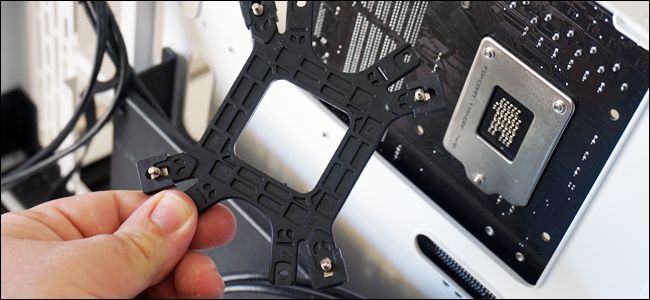
Assemble the backplate for the larger cooler. This is required because of the larger size and weight of these coolers: they need to have a more secure footing to avoid warping the motherboard.
组装较大冷却器的背板。 之所以需要这样做,是因为这些散热器的尺寸和重量更大:它们需要有一个更牢固的立足点,以免使主板翘曲。
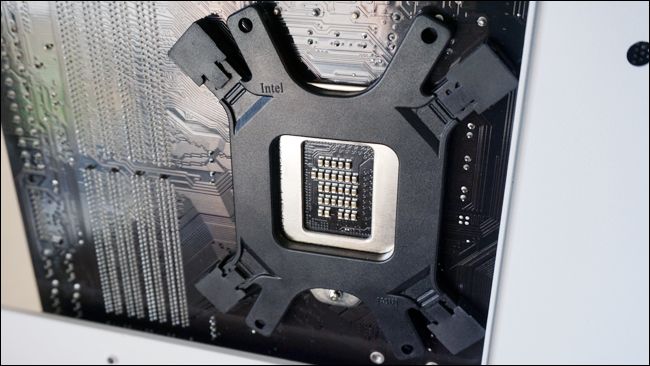
Most aftermarket coolers have separate instructions and parts for various Intel and AMD sockets; this one required me to put screws into specific tabs and set them up for the LGA 1151-series CPU socket.
大多数售后冷却器针对各种Intel和AMD插槽都有单独的说明和零件。 这需要我将螺钉拧入特定的卡舌中,并为LGA 1151系列CPU插槽设置它们。
With the backplate in place, move the case around so you’re once again facing the “top” of the motherboard. Install the risers on the screws coming up from the cooler mounting plate. You may need to “hug” the case to hold the mounting plate steady while you screw down the risers with your other hand.
装好背板后,移动机箱,使您再次面对主板的“顶部”。 将提升板安装在冷却器安装板上的螺钉上。 在用另一只手拧紧提升板时,您可能需要“拥抱”机箱以稳固安装板。
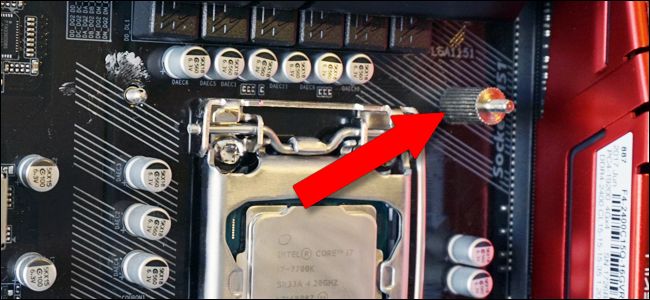
With the plate securely in place and the risers set, lay your case down once again in its original work position, with the front panel on your right side. Leave the rear panel removed, it will save you time later.
牢牢固定好板子并固定好提升板之后,将机箱再次放回其原始工作位置,并且前面板在右侧。 卸下后面板,这样可以节省您的时间。
Continue to follow the instructions to install your specific cooler. In our case, that included screwing down these steel brackets and securing them with nuts and the included wrench, then installing a retention screw for the cooler itself.
继续按照说明安装特定的散热器。 在我们的案例中,这包括拧紧这些钢支架,并用螺母和随附的扳手将其固定,然后为冷却器本身安装固定螺钉。
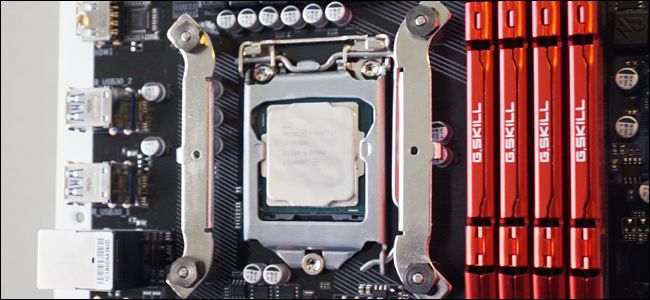
Before you set the cooler in place, you’ll need to apply thermal paste to the top of the CPU. There are a lot of different opinions about the proper technique here, but the easiest and most reliable way to go about it is “just put a pea-sized drop in the middle.”
在将散热器安装到位之前,您需要在CPU顶部涂抹导热膏。 关于正确的技术,这里有很多不同的观点,但是最简单,最可靠的实现方法是“在中间放一个豌豆大小的水滴”。
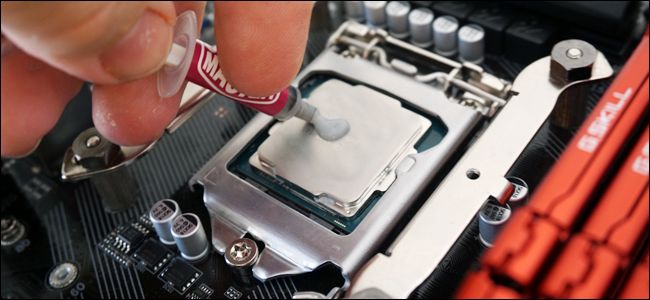
With the paste in place, set the cooler down and secure it to the mounting bracket; with our model that means clipping it in on one side and screwing it down on the other.
粘贴到位后,将冷却器放下并将其固定到安装支架上; 使用我们的模型意味着将其夹在一侧,然后拧紧在另一侧。
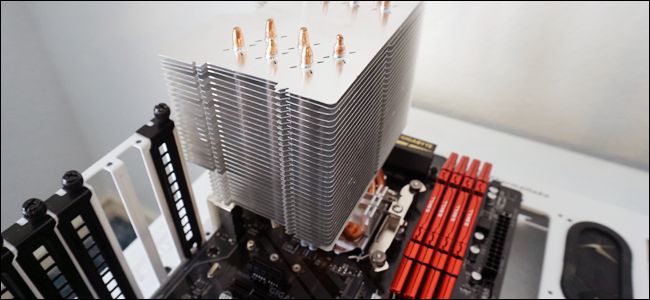
Finally, attach the fan onto the cooling fins (this may already be done for some coolers).
最后,将风扇连接到散热片上(某些冷却器可能已经这样做)。

When you’re done, plug the fan into the motherboard, using the same three- or four-pin power port used by the stock cooler.
完成后,使用库存冷却器使用的相同的三针或四针电源端口将风扇插入主板。
第六步:安装存储设备和光盘驱动器 (Step Six: Install the Storage and Optical Drives)
Our basic machine has only one small SSD for storage, but whatever form of storage you’re using, it’s pretty simple to get it installed. Your case will have either permanent mounting locations (like ours, right on the side) or sliding caddies that let you screw in the drive and then slide it into a slot for easy removal and replacement. Either your case or your drive itself should include screws to secure it in place. Check your case’s instruction manual if it’s not immediately obvious where your storage drives should go.
我们的基本机器只有一个小的SSD用于存储,但是无论您使用哪种存储形式,安装它都非常简单。 您的机箱将具有永久性的安装位置(如我们的右侧),或滑动式机架,可让您拧紧驱动器,然后将其滑入插槽,以方便拆卸和更换。 您的机箱或驱动器本身都应包括螺钉以将其固定到位。 如果尚不清楚存储驱动器应运往何处,请查看案例的说明手册。
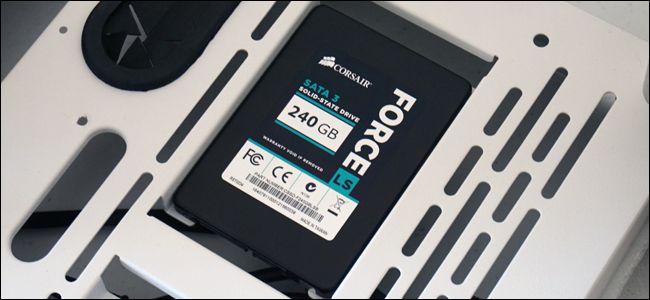
Our SSD drive goes in a little groove on the side of the case. I raised the case to the vertical position again, then inserted and tightened the screws from the back. Easy peasy. (The case also has larger brackets for optional 3.5-inch hard drives, which we’re not using.)
我们的SSD驱动器位于机箱侧面的小凹槽中。 我再次将外壳提升到垂直位置,然后从背面插入并拧紧了螺钉。 十分简单。 (该机壳还有用于可选的3.5英寸硬盘驱动器的较大支架,但我们没有使用。)
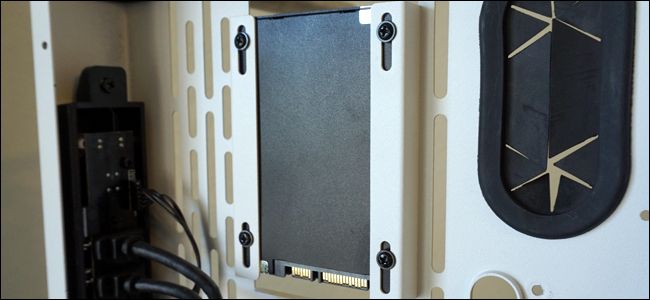
Once your storage drive is in place, connect the SATA data cable to the SATA port on both the drive. There’s only one way the cable can fit, and it’s the same connection on both sides.
存储驱动器到位后,将SATA数据电缆连接到两个驱动器上的SATA端口。 电缆只有一种安装方式,并且两端的连接方式相同。
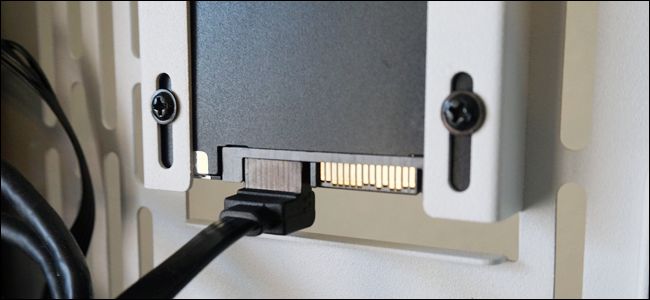
Then, plug that same cable into the SATA port on the motherboard. Repeat this process for as many SSDs or hard drives as you’re planning to use.
然后,将同一根电缆插入主板上的SATA端口。 对您计划使用的尽可能多的SSD或硬盘重复此过程。
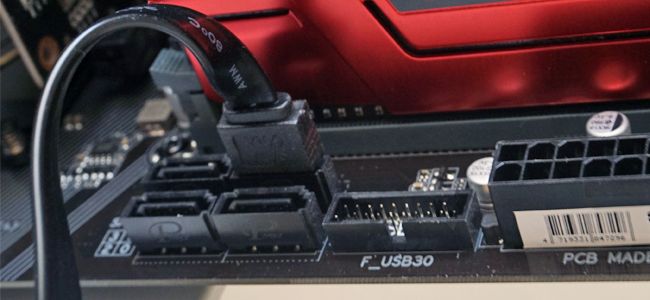
Installing a DVD drive, if you have one, is also pretty simple. On cheaper, simpler cases, just slide it into place in the large 5.25″ bay at the front and screw it down with the included screws. More elaborate cases have only one more step: screw in the runners on the side of the drive, then slide the drive into place. Like the caddies for SSDs and hard drives, this just makes it easier to take replace the drive.
安装DVD驱动器(如果有)也非常简单。 在更便宜,更简单的情况下,只需将其滑入前部5.25英寸大托架中的位置,然后用随附的螺钉将其拧紧即可。 更复杂的情况仅需采取以下步骤:拧紧驱动器侧面的滑槽,然后将驱动器滑入到位。 就像用于SSD和硬盘驱动器的驱动器一样,这使得更换驱动器更加容易。
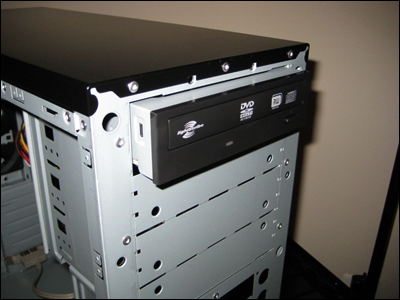
In either case, plug the SATA data cable into the drive and the motherboard, just like you did for the hard drive, and you’re ready to go.
无论哪种情况,都可以将SATA数据线插入驱动器和主板中,就像为硬盘驱动器那样,就可以开始使用了。
第七步:安装图形卡(和其他PCI-e附件) (Step Seven: Install the Graphics Card (and other PCI-e Accessories))
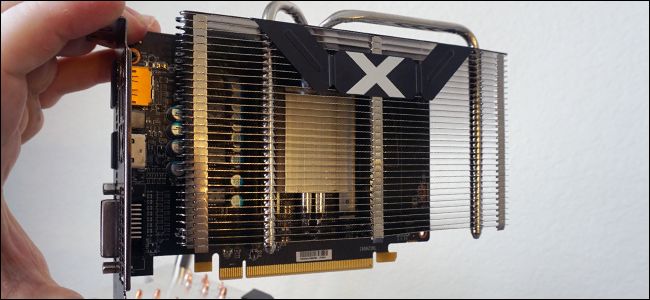
If you’re using a discrete graphics card for gaming, you’ll want to install it now. It uses a PCI-Express (abbreviated PCI-e, PCIe, or sometimes just PCI) slot, which opens to the outside of the case for expansion ports and is almost always found beneath the CPU socket on the motherboard.
如果您使用独立显卡进行游戏,则需要立即安装。 它使用PCI-Express(缩写为PCI-e,PCIe,有时仅是PCI)插槽,该插槽在机箱外部用于扩展端口,并且几乎总是在主板上的CPU插槽下面找到。
First, determine which of your PCI-e ports uses the x16 speed lanes. It should have PCIEX1_16 or a similar designation: it will be the slot closest to the CPU and the longest (or tied for the longest). If this stuff is confusing, check out this article on using the right PCI-E accessories in the right slots.
首先,确定您的哪个PCI-e端口使用x16速度通道。 它应该具有PCIEX1_16或类似的名称:它将是最接近CPU且最长的插槽(或最长的插槽)。 如果这些东西令人困惑,请查看有关在正确的插槽中使用正确的PCI-E附件的文章。
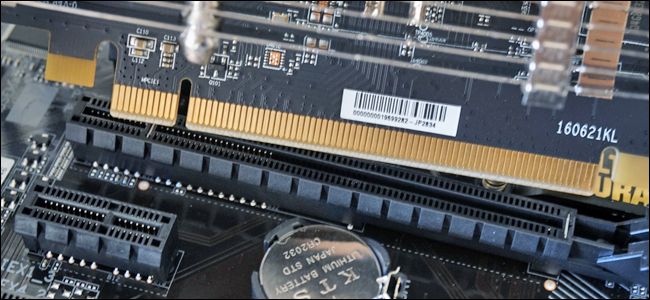
Now remove the rear cover for that slot (or slots, if your card is big enough that it needs to have two of them removed). These little metal or plastic pieces are just there to protect your computer’s insides for PCI-E slots that aren’t being used. Now lower the plastic tab at the end of the slot—this works a lot like the RAM modules, but only one one side. Slide the graphics card in, starting with the side closest to the outside of the case. Press firmly down until the tab locks into place.
现在,卸下该插槽(或多个插槽,如果您的卡足够大,需要卸下其中两个)的后盖。 这些小金属或塑料件就在那儿,以保护未使用的PCI-E插槽的计算机内部。 现在放下插槽末端的塑料卡舌,这很像RAM模块,但只有一侧。 从最靠近外壳外部的一侧开始,将图形卡滑入。 用力向下按,直到卡舌锁定到位。
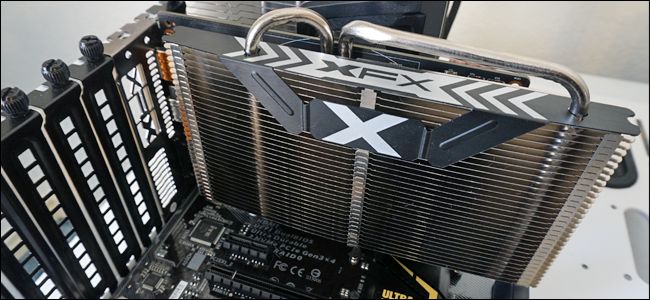
Then, put the thumbscrews back in where they came from, securing the card in place.
然后,将指旋螺钉放回原来的位置,将卡固定到位。
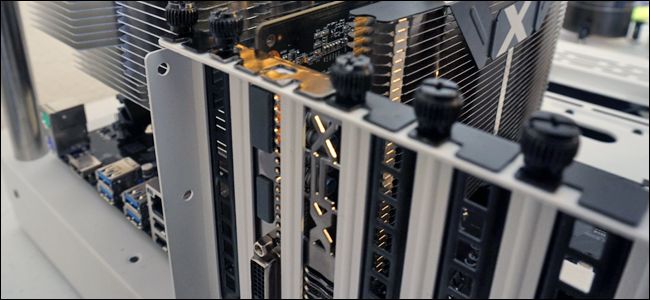
第八步:安装电源 (Step Eight: Install the Power Supply)
You’re getting close to the end here. Slide the power supply into its bay or bracket. The part that accepts the three-prong power cable (the one that plugs into the wall) should be flush with the back of the case, and accessible from the outside.
您在这里快要结束了。 将电源滑入其托架或支架中。 接受三芯电源线的那部分(插入墙壁的那一部分)应与外壳背面齐平,并可以从外部接触。
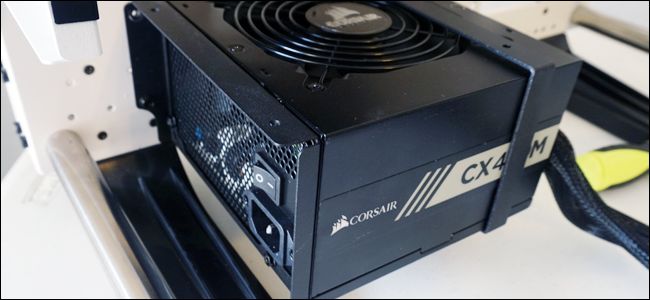
Depending on the design of your case, you may want to mount it so the fan is facing either up or down. Most people like to have the fans facing outside the case (fan up if the power supply is at the top of the case, fan down if it’s at the bottom), as this will let your power supply take in cooler air. But to be honest, it doesn’t make a huge amount of difference—your power supply won’t overheat unless you chose one that’s insufficient for your computer. If it’s easier to access components the other way, that’s fine, as long as there’s a bit of clearance between the fan and the closest non-mesh surface.
根据机箱的设计,您可能需要安装它,使风扇朝上或朝下。 大多数人喜欢使风扇面向机箱外部(如果电源位于机箱顶部,则风扇向上通风;如果电源位于底部,则风扇向下通风),因为这会使您的电源吸入较冷的空气。 但是,老实说,这并没有太大的不同-您的电源不会过热,除非您选择的电源不足以容纳计算机。 如果通过另一种方式访问组件更容易,那很好,只要风扇和最近的非网格表面之间有一定的间隙即可。
Different cases have different spots to secure the power supply in place, but generally you’re going to be using at least four screws. Sometimes you may need to screw the supply in place via the holes on the outside of the case.
不同的机箱有不同的位置可将电源固定到位,但是通常您将至少使用四个螺钉。 有时您可能需要通过外壳外部的Kong将电源固定到位。
When the power supply is firmly in place, it’s time to plug it in to all of the components that need power from it. Remember that you can run the cables through more or less any hole, and it might be best to use the back of the case to keep things from getting tangled or catching on the fans.
电源固定到位后,就该将其插入需要其供电的所有组件了。 请记住,您可以将电缆穿过或多或少地穿过任何Kong,并且最好使用机箱的背面以防止缠绕或缠绕风扇。
From biggest to smallest:
从最大到最小:
Motherboard: 24-pin cable (sometimes more). This is usually on the right-hand side of the motherboard in its mounted position. look at the pattern of the plastic molding around the pins: there’s only one way it will fit.
主板:24针电缆(有时更多)。 它通常位于主板右侧的安装位置。 看一下销子周围的塑料模制图案:只有一种适合的方法。
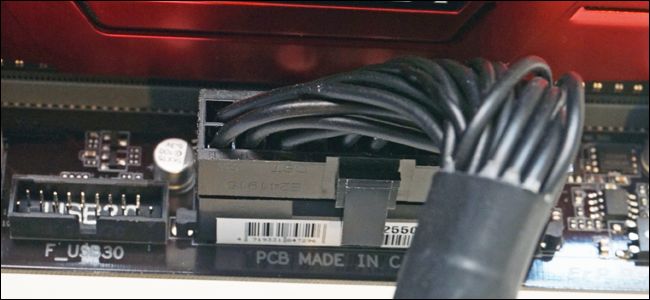
CPU: 4, 6, or 8-pin cable (sometimes more). This port is also on the motherboard, but it’s somewhere near the CPU socket, often at the top left. Again, there should only be one way to plug this in.
CPU :4、6或8针电缆(有时更多)。 该端口也位于主板上,但位于CPU插槽附近,通常位于左上方。 同样,应该只有一种方法可以将其插入。
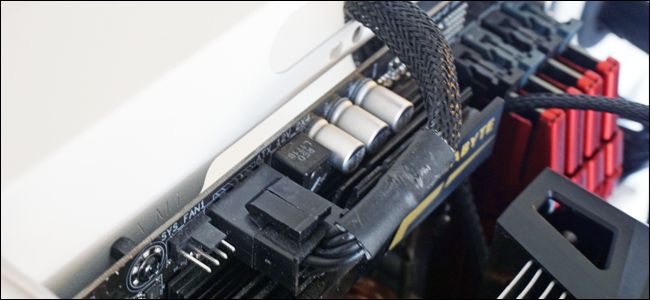
Storage drives and DVD drives: SATA power cables (the ones with the L-shaped connectors). Most modern power supplies will include at least one SATA power cable, often with sockets for multiple drives that you can use at the same time.
存储驱动器和DVD驱动器:SATA电源电缆(带有L形连接器的电缆)。 大多数现代电源设备将至少包括一根SATA电源线,通常带有用于多个驱动器的插槽,您可以同时使用它们。
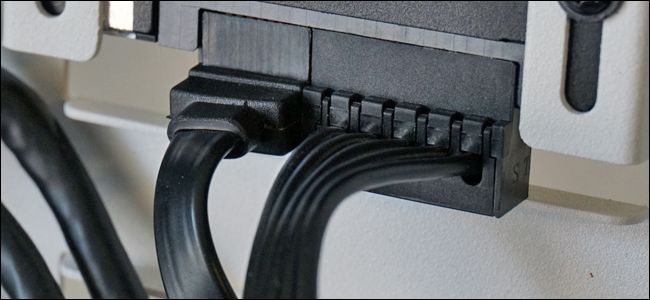
Graphics card: 6, 8, 12, or 14-pin cable, depending on how powerful the card is. (Ours is a low-power model that gets all of its electrical power from the motherboard, and it doesn’t need a direct connection to the power supply). For very powerful cards, you may need to use multiple power cables for a split connection, but again, each individual cable should only be able to fit one way.
图形卡:6、8、12或14针电缆,具体取决于图形卡的功能。 (我们的是一种低功率型号,可以从主板上获取所有电能,并且不需要直接连接到电源)。 对于功能非常强大的卡,您可能需要使用多根电源线进行拆分连接,但是同样,每条单独的电缆只能以一种方式安装。
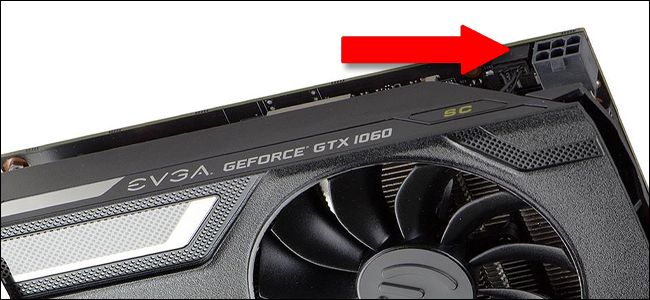
Case fans, coolers, and radiators: Connect the cooling equipment to the power supply with whatever it needs. Some fans with a four-pin connector can attach directly to the motherboard, but others need to be plugged into a power supply rail. You may need molex adapters or SATA adapters if you have more than two or three fans, but generally the power supply comes with enough extra cables for most basic builds.
机箱风扇,冷却器和散热器:根据需要将冷却设备连接到电源。 一些具有四针连接器的风扇可以直接连接到主板,但是其他风扇则需要插入电源导轨中。 如果您拥有两个或三个以上的风扇,则可能需要Molex适配器或SATA适配器,但是通常电源随附的附加电缆足以满足大多数基本构建要求。
Anything else you’re likely to install should be able to draw its power directly from its connection to the motherboard.
您可能要安装的任何其他产品都应该能够直接从其与主板的连接中获取电源。
第九步:插入外壳控件,音频和USB电缆 (Step Nine: Plug in the Case Controls, Audio, and USB cables)
The last thing you’ll need to plug in are the cables for your case—these connect the power and reset buttons, the front-mounted headphone and microphone jacks, and any USB ports on the front of the case to the motherboard.
您需要插入的最后一件事是外壳的电缆-它们连接电源和重置按钮,前置耳机和麦克风插Kong,以及外壳前面与主板的任何USB端口。

The power buttons and lights are the trickiest here, because they’re really tiny electrical cables that have to plug into very specific pins on the motherboard’s I/O panel. This panel is usually at the bottom-right of the board. Depending on how your case is laid out, you’ll definitely have a two-pin power cable, a two-pin cable for the light that shows you the computer’s on, and possibly a two-pin reset cable and a two-pin “HD,” “IDE LED,” or “Drive” cable (for the little light that blinks whenever your computer is accessing its storage drive). Some or all of these might be broken into positive and negative connectors.
电源按钮和指示灯是最棘手的,因为它们实际上是很小的电缆,必须插入主板I / O面板上非常特定的引脚。 该面板通常位于面板的右下角。 根据机箱的布置方式,您肯定会使用两针电源线,用于显示计算机电源的两针电源线,以及两针复位电缆和两针“ HD”,“ IDE LED”或“ Drive”电缆(用于当计算机访问其存储驱动器时闪烁的小灯)。 其中一些或全部可能会分为正极和负极连接器。
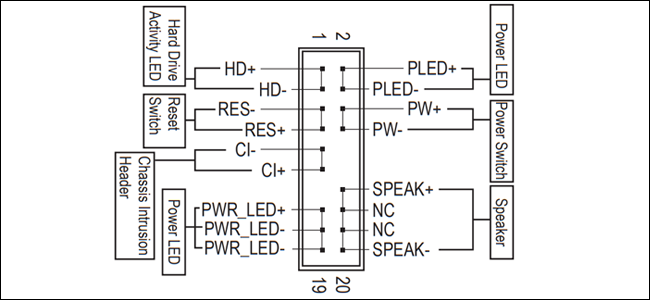
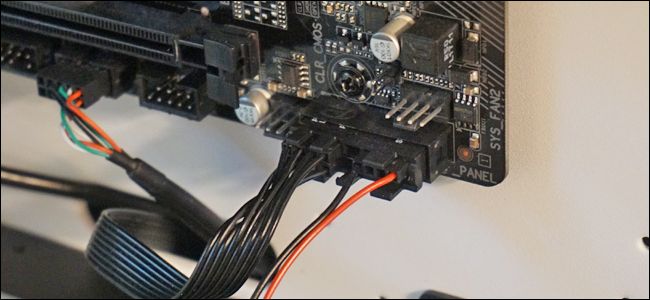
These get frustrating because they’re tiny and hard to read. It’s best to break out your motherboard’s manual and look for specific instructions on the I/O panel. Our motherboard came with a handy little plastic piece that was pre-labelled, and our case has nice bright white labels on the cable itself, making the whole process fairly obvious. Double-check these connections with the motherboard manual if you’re not sure about them: you need the power button to be right at the very least if you want your PC to turn on!
因为它们很小并且很难阅读,所以它们令人沮丧。 最好拆开主板的手册,并在I / O面板上查找特定的说明。 我们的主板带有一个方便的,预先贴有标签的塑料小块,并且外壳上的电缆本身带有漂亮的亮白色标签,使整个过程相当明显。 如果不确定这些连接,请与主板手册仔细检查:如果要打开PC,则至少需要电源按钮正确!
The USB and audio connections are more obvious: they’ll plug into specific sockets on the motherboard, usually labelled as such. Our case has one for the USB 2.0 ports, another and another similar-looking one for the audio jacks, both of which plug into the bottom of the motherboard.
USB和音频连接更加明显:它们将插入主板上的特定插座,通常标有相应名称。 我们的机箱有一个用于USB 2.0端口,另一个用于音频插Kong,外观相似,两个都插入主板的底部。
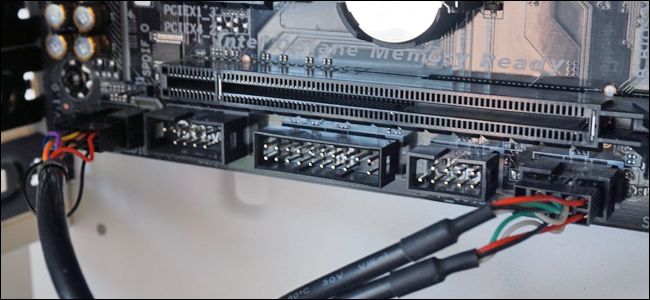
The bigger plastic cable for the USB 3.0 jacks goes in the side. Again, if you can’t find the specific plugs for your motherboard, consult the manual—it should have a diagram either of the parts of the whole board or the specific locations of the connections for the case’s front buttons and inputs.
USB 3.0插Kong的较大塑料电缆在侧面。 同样,如果找不到主板的特定插头,请查阅手册,该手册应包含整个电路板的各个部分的图,或机箱正面按钮和输入的连接的特定位置的图。
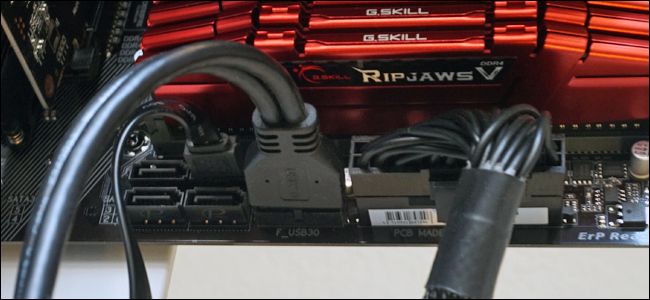
结语! (Wrap It All Up!)
You’re nearly done. Before you close up your case, double-check to make sure none of the power or data cables are too close to one of the case or cooler fans, and that everything is firmly in place and locked down. Looks good? Then put the front and rear covers on and secure them in place with the thumbscrews.
您快完成了。 在合上机箱之前,请仔细检查以确保电源线或数据线都没有太靠近机箱或冷却风扇之一,并且所有物品都已固定到位并锁定。 看起来不错? 然后放上前后盖,并用翼形螺钉将它们固定到位。
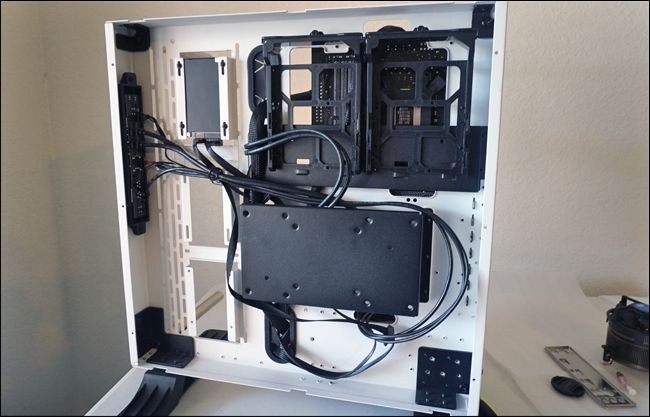
Plug in the power cable to the power supply, then your monitor, keyboard, and mouse. Press the power switch. If you can see the power indicator light on the case, hear the case fans, and see the motherboard logo (known as the POST screen), you’re all ready to install your operating system. Congratulations, you’ve successfully assembled your PC!
将电源线插入电源,然后将显示器,键盘和鼠标插入。 按下电源开关。 如果您可以看到机箱上的电源指示灯亮起,听到机箱风扇的声音并看到主板徽标(称为POST屏幕),那么您已经准备好安装操作系统。 恭喜,您已经成功组装了PC!
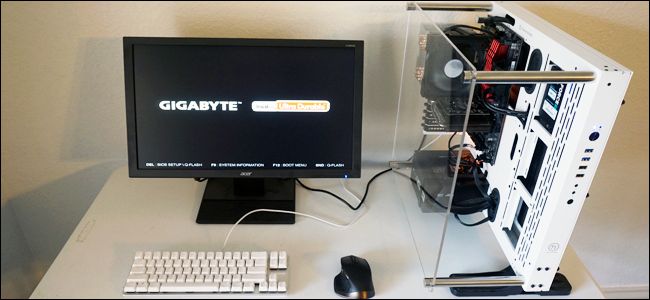
If for some reason the power didn’t come on, unplug the PC and the accessories, then double-check these common problems:
如果由于某种原因无法接通电源,请拔下PC和配件的电源,然后再次检查以下常见问题:
- Did you have the power switch on the power supply in the right position? This is the switch accessible from the outside of the case; the “I” should be down and the “O” should be up. 您的电源开关是否在正确的位置? 这是可以从盒子外部访问的开关。 “ I”应该向下,“ O”应该向上。
- Did you plug the power cable from the power supply into the CPU power socket on the motherboard? This is the smaller of the two cables going from the power supply to the motherboard, usually somewhere near the CPU socket at the top of the board. 您是否将电源线从电源插座插入主板上的CPU电源插座? 这是从电源到主板的两条电缆中较小的一条,通常位于主板顶部CPU插槽附近。
- Are all the RAM sticks securely in place, with the plastic clips clamped down? 是否将所有RAM棒牢固地固定到位,并用塑料夹夹住?
- Is the CPU cooler connected to the motherboard for power? CPU散热器是否已连接至主板以供电?
- If you’re using a graphics card, did you plug the monitor cable into the card instead of the video-out port on the motherboard? 如果使用的是图形卡,您是否将监视器电缆插入了图形卡而不是主板上的视频输出端口?
- If you’re using a graphics card, did you plug it into the PCI-E slot on the motherboard firmly, with the plastic clip clamped down? Did you use the correct power cable to connect it to the power supply (if it needs one)? 如果您使用的是图形卡,是否已将塑料卡夹向下牢固地插入了主板上的PCI-E插槽? 您是否使用正确的电源线将其连接到电源(如果需要)?
- Did you have the case’s power switch cable in the right pins on the motherboard’s I/O panel? 机箱的电源开关电缆是否在主板的I / O面板的正确插针中?
Once your system POSTs properly, it’s time to prepare your BIOS and install your operating system. Proceed to the next article for more information.
一旦系统正确开机自检,就可以准备BIOS并安装操作系统了。 继续下一篇文章以获取更多信息。
Or, if you want to jump to another part in the guide, here’s the whole thing:
或者,如果您想跳到指南的另一部分,请参阅以下内容:
Building a New Computer, Part One: Choosing Hardware
构建新计算机,第一部分:选择硬件
Building a New Computer, Part Two: Putting It Together
构建新计算机,第二部分:组装在一起
Building a New Computer, Part Three: Getting the BIOS Ready
构建新计算机,第三部分:准备BIOS
Building a New Computer, Part Four: Installing Windows and Loading Drivers
构建新计算机,第四部分:安装Windows和加载驱动程序
Building a New Computer, Part Five: Tweaking Your New Computer
构建新计算机,第五部分:调整新计算机
翻译自: https://www.howtogeek.com/howto/uncategorized/building-a-new-computer-part-2-putting-it-together/
计算机组装和维护






)









)

配置DHCP服务器)
